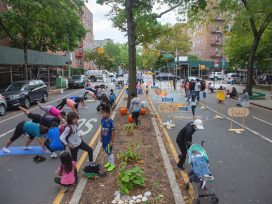The possibility of a co-city
In interview, Christian Iaione discusses the concept of the “co-city” – a city that is both cognitive and collaborative – which has been implemented in Bologna. Could this mark the beginning of a new era of urban co-governance? And what do the rise of bottom-up initiatives mean for the future of the welfare state?
Anne de Zeeuw: In the American Journal of Economics and Sociology, you write about the city as a commons, could you describe how the management of such a city differs from the current situation? You no longer have one city hall, but a distributed network of city halls in which even the single household could become – if governance is polycentric – an atom in the makeup of the city hall. How does this function?
Christian Iaione: Well, if a household starts producing energy or saving water, or becomes part of a distributed and shared wireless network, it becomes part of a supply chain and does not only react to demand. This is different form the current situation, where public and private organizations produce goods for consumers. The typical city hall regulates, controls or provides services. It produces something to satisfy public demand. The product can be services like policing and prosecutions. When looking at the collaborative city hall, we see that it works more along the lines of transforming demand through production units. Think of all these new citizen co-operatives that produce energy.
Michiel Hulshof: So this means that people become producers and users at the same time?
They produce, they use their product and they sell their surplus to the grid. That way, they get money out of the grid. With that money they can pay for other services, like wireless internet or even social services. This is something that is actually happening in a few countries, like in Italy. So, in one building there are elderly people who share solar panels for the production of energy and then they collectively hire a nurse to take care of them. That way they do not have to move to residential homes for the elderly. The elderly people stay in their own houses and share healthcare services. And at the same time they become part of a unit that produces energy.

Bologna by night. Photo: MartinaFerrara. Source: Wikimedia
How would the management of all this differ from the current situation? For instance, how would the local healthcare system be managed?
The difference is that this kind of idea of collaborative commons is really based on commons design principles. This means that they should be run by hyper-local co-ops that are more democratic, so that households do not simply use a grid owned by some company that has its offices somewhere else. There’s a risk, though. The same thing that happened with Uber and Airbnb – where users do not have any voice – could also happen with the production of energy within households. Users may end up in a hierarchical structure after all. Then the ownership of the grid is private, and it is no longer possible to incorporate social values, social goals or environmental goals into the matrix. Private owners are not committed to the commons. It is the commitment to the commons that makes the difference.
What kind of goods can be co-produced in this ideal situation?
Not everything. As Tine de Moor would say: “you don’t share the toothbrush” but you can share your kitchen, which used to be the most private kind of environment. You could share the wireless internet, you could share energy production, you could share food and lifestyles. You have local groups in Italy for buying food, so-called Solidarity Purchase Groups. Together, these groups buy all the veggies and other sorts of food grown locally, and this is part of the social and solidarity economy movement. They have a whole chain that is outside the normal distribution chain, otherwise, they would not be able to bear the costs. So they have parallel structures in which basically the network of local farmers creates a logistics platform that then serves all sorts of consumers who create dispatch points within private or shared spaces in communities, it depends on the area. You create a so-called solidarity economy district.
Where is the solidarity in this system?
Solidarity exists in the relation between the producer and the consumer, a direct relation without any intermediary. This is part of the co-city at the polycentric level. It is when you change your lifestyle and, instead of buying food that is produced millions of miles away, that produces emissions and transportation costs, you buy local, you go local. In cities people are not really living this paradigm. The current social paradigm is going to the supermarket to buy things and not caring about the origin. For example, in New York, where I lived ten years ago, I had a problem finding proper nutrition because the whole food paradigm in the States is very different from the Italian one. So, it was really difficult for me to go to the supermarket, because there you could find mainly products full of fats – unhealthy food. It was right then that the whole foods movement started. Whole food supermarkets bring together all the local products from everywhere in the world. I thought at first that it was good, because you have the genuine thing. But I didn’t think about the distances that this specific food travelled, because you would have salmon from the North Sea or tuna from Japan. In Italy it is the same, Italy is now shipping Italian products to everywhere in the world. It is pushing to produce more than the country needs. To change that scenario you should look for local farmer markets.
Ok, so we can share energy, food, lifestyles, and more?
Also water efficiency, and waste treatment. Maybe in large cities, in global cities, recycling is by now both mandatory and a social norm, but if you come to Rome or you go to the cities in the Global South, waste is widespread. Even Amsterdam and other western cities produce a lot of trash. So we should start thinking about the way people act in the city by saying, like the Fab City movement says, let’s produce things that have nine lives because they are specifically designed to be recycled. It is the social paradigm that has to change. To go polycentric you need to change behavior. People should understand that they need to buy things that are recyclable, that they need to recycle, they need to be more careful and more conscious about what they buy and, in general, about their behavior in the city. That is the very last layer or ingredient of a co-city.
In such a polycentric city, how do you make sure everybody gets what they need?
There are different levels. You go from sharing to collaboration, then to cooperation, and then you go polycentric. You start at a basic level, you simply start by sharing the urban commons. Then you start creating collaboration between local businesses to run certain areas. Then you might end up creating institutions that are cooperative in their DNA. And then you go polycentric when you create a regulatory framework that sparks and fosters the kind of behaviors that I was talking about.
Could you also make the welfare state polycentric or is this a step too far?
No, this is all about the welfare state. If you think about hospitals, they are usually perceived as the place where you have to go when you are sick and this creates waiting lists. But most care could start in the single household. You could have doctors who are dedicated to single households, to single buildings. So instead of having the hospital as a hub, you would have a distributed healthcare system. Like my grandfather used to do, he was a doctor in a small village in the south of Italy. Because there were no hospitals he would go from house to house to take care of people. The same approach was recently reintroduced in Emilia Romagna as a way of avoiding backlogs and waiting lists – many people have sicknesses that could be prevented easily by taking care of them at home.
We actually have this system in the Netherlands, you first need to go to your local doctor before you can go to a hospital.
What I am saying is that maybe you should not have a patient going to the doctor, but rather the doctor going to the patients. It would cost less, because when there is a pool of inhabitants then you could also have a dedicated pool of doctors. Then you see intermediation. You group together the demand, and you group the offer and you enable the encounter between these two pools.
I always take the example of elderly people. This is also because of my personal experience: my grandmother died because she fell in her apartment as a result of slipping up on her carpet. If doctors would visit people at home, they would probably give them advice like: “You should have a light here, because you don’t see the steps, you should take out the carpets because you can slip.” These are simple things that matter.
So this system is focused on individual needs, how does it take care of general needs?
The answer is straightforward – by treating individual needs and aggregating them you help the public. So, look at the figures on how many accidents happen to elderly people at home, and then consider how many could have been prevented just by giving these people some good advice. Then you see that a lot of money could be saved, so it is about taking care of the public.
If you have this distributive system, parts of it will fail while other parts flourish. So there will be experiments that work and experiments that do not work. Who pays for the costs of failure?
Who pays for huge programmes that do not really have an impact? How much time do we need to change the framework before we understand that something is wrong? How much money must we spend before we realize that something is not working anymore? There are giant public programmes that use a lot of money yet only lead to new reform. By the time you understand that the reform is obsolete you have spent a lot of money. If we don’t consult the people when creating major infrastructure and people then oppose the infrastructure project, then we are basically throwing finances away. That’s the cost. And the cost is carried by the state and by the collectivity – we are all paying.
But in the distributed system, not all of us would be losing. Only some people would lose.
It is not about losing or winning; it is about common learning. Justice Brendice of the Supreme Court used to say that states in the US are laboratories for experimentation. He said so, because each state could learn from the mistakes of the others and improve their public policy following various cycles of experimentation. So distribution, polycentrism, federalism is about this basically, it is about learning from each other. Autonomy means allowing people to find new ways, and then to look at these new ways and maybe improve upon them by learning from each other. And then the other aspect is ring-fencing, so that by giving more autonomy, you decrease the amount of risk. Because when someone fails, their failure is contained. You make sure it doesn’t spread through the system.
What to do with the few people that are in this nasty position?
You have to create a kind of parachute for those who fail. There should be no stigma in failing and making mistakes. We should invest culturally and economically in reframing failure as just the next step toward future success. And, of course, you should strike a balance so that people do not become failure-oriented, there should be some means of recovery made available.
Do you then think that there should be a combination of welfare state and polycentric state?
Yes, definitely. The welfare state is here to stay. I am not saying that we should get rid of the Leviathan State or the Gargantuan State, but that we need to rebuild the form of the State. I call this the third institutional revolution. That is, going from the Leviathan to the Gargantuan, and from the Gargantuan to a new type of state.
How do you deal with the division between active citizens who innovate and non-active citizens who remain dependent on the welfare state?
So far, we are used to having these two morphologies. What I am saying is that city makers, social innovators, active citizens and urban farmers among others are giving birth to a third form of state – which is not Leviathan or Gargantuan. These are there to stay, because you still need someone to provide safety, like the police. I wouldn’t have policing run as a private entity. That is not governance of the commons, that is something else. That is big society, or substitution, or private cities. You have neighborhood watches. I don’t think that they should be perceived as governance of the commons, because they are more a form of substituting public services for the public themselves. What I am saying is that, instead, you should have forms of co-management. I don’t want to end up in a private city, a gated community, in which policing is privatized, and where I have no democratic rights.
Do you have to have a strategy to prevent such complete privatization?
The first strategy is to be aware of it. This could be interpreted as going towards complete self-organization, complete privatization. This is where the studies that Elinor Ostrom carried out, and those that Sheila Foster and I conducted, differ. Because in a city, self-organization is not enough, you need co-organization. You need co-governance. You don’t need self-government. You need to have the public involved because the public should take care of the needs of those who are not able to take care of themselves; you also need to have the public as a watchdog, as a referee, as a sort of vigilant entity that also preserves democracy. That is the ultimate, the universal service; what is called universal service in the European Union’s terms should be guaranteed by the public.
So there is a key difference between self-organization and co-organization?
Yes, that is why I call it “urban co-governance” instead of urban self-governance. Actually Ostrom said, with reference to the eight design principles, that once the scale of the commons is greater and the stakes are higher and more complex, then you need to have multi-layered nested enterprises. For me, that is what urban co-governance is about. It is about creating nested enterprises. In the city, you need to have nestedness. Because you cannot run the city as a commons without involving the private sector. I think it is stupid to imagine that you can throw out the private sector, since it is an important actor and to do so would only create conflicts. Which does not mean you give them veto powers, but you need to take them into account. You need to enable citizens. They should not just be involved, they should be driving the process as managers. Then you have the public overseeing the process, and as a last resort the judicial system should be in some way open to the public too.
If you created a map of bottom-up initiatives, just starting spontaneously, they are usually limited only to certain groups, right?
Yes, that is the sharing level, which is the first level. If such initiatives remain at this level in a city, they are going to die, they are not going to survive, except for maybe just a few of them. On this level you do not turn the whole city into a commons, you just cultivate sharing practices. You do shared governance for single urban commons, single assets. You do not update the overall framework. In the city as a commons, urban democracy is completely different. Elections may become useless. We now know that elections do not always guarantee the democratic quality of democracy, the system can be broken and become contaminated, influenced by the money that is injected into the electoral process.
In the previous discussion on The commons and the principle of equality, you mentioned that we need to differentiate between equality of opportunity and equality of outcome. Could you briefly explain “equality of outcome”?
This can be explained using the metaphor of a running race. The first dimension is equality before the law, a formal equality. This means that everybody should be able to participate in the race. Then equality of opportunity means that everybody should be on the blocks, even those who are poor or sick. That is what the welfare state tries to do, put everybody on the starting blocks. That is all ex ante, but nobody cares about ex post.
So, equality of outcome asks: how do we make sure that the race does not end up perpetuating divides? This is very complex. At first, someone was going to win. Are we now to make sure that no one wins at all? What we should in fact do is adjust the differences in the prices of welfare, which should not be so large that they create deeper divides in society.
Further reading
Christian Iaione, “The CO-City: Sharing, Collaborating, Cooperating, and Commoning in the City”, American Journal of Economics and Sociology 75, no. 2, March 2016, 415-55, dx.doi.org/10.1111/ajes.12145
This is a lightly edited version of an interview with Christian Iaione first published in Political Critique’s Connected Action for the Commons section on 6 December 2016.
Published 22 February 2017
Original in English
First published by Political Critique, 6 December 2016
© Christian Iaione, Anne de Zeeuw, Michiel Hulshof / Political Critique / Eurozine
PDF/PRINTIn collaboration with
In focal points
Newsletter
Subscribe to know what’s worth thinking about.
Related Articles

On making commons concrete
The Dutch Review of Books 2/2021
‘The Dutch Review of Books’ presents: the commons, vying for legitimacy between state and capitalism; the void of societal responsibility for #MeToo; and African oral traditions evident in rap music.

Democratic ‘Third Places’
dérive 10–12/2020
Urbanist magazine ‘dérive’ on emancipating Brazilian museology; the potential for Polish cultural centres; Swiss commons as a transferable prototype; and post-explosion Beirut.






